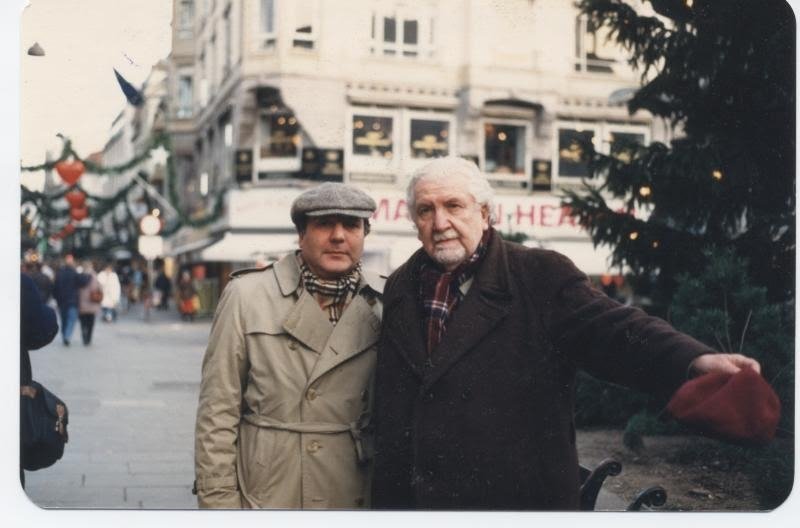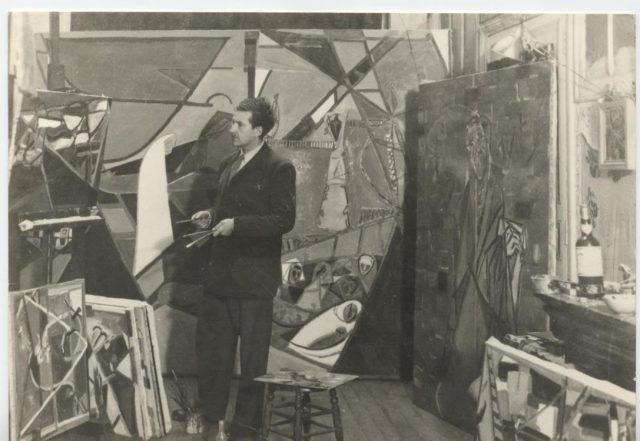To understand Nejad Melih Devrim, who was born in Istanbul in 1923 and is the grandson of General Şakir Paşa of the Ottoman Empire, we must first delve into the illustrious “Şakirpaşa Family” to which he belongs.
The artist’s mother was the renowned painter Princess Fahrelnissa Zeid, and his father was Izzet Melih Devrim, a writer associated with the Fecr-i Ati. Fecr-i Ati was a short-lived literary group founded in 1909, aiming to modernize Ottoman literature by drawing on Western literature and focusing on themes of love and nature.
His sister, Şirin Devrim, was a celebrated theater actor. Additionally, his uncle, Cevat Şakir Kabaağaçlı, is better known by his pen name, Halikarnas Balıkçısı, his aunt was the printmaker Aliye Berger, and his cousin was Füreya Koral, a pioneer of ceramics in Türkiye. It would not be an exaggeration to say that Nejad Devrim grew up in a family with a remarkably vibrant artistic background. With nearly every member involved in the arts, this family has inspired films, television series and even school curricula.
Şirin Devrim describes her life in her autobiography, “Şirin,” as, “The story of my life woven with good and bad coincidences.” Similarly, the lives of almost all members of the Şakirpaşa family have been characterized by this very essence: passionate, graceful, entertaining, tumultuous, dramatic and inspirational.
Artistic journey, Paris years
Nejad Devrim’s artistic journey was extraordinary, rivaling the talents of other family members. From a young age, he began unlocking the doors to his passion for art with his first pencil. His early paintings at just 17 years old clearly showed the great artist he was destined to become.
After completing his secondary education as a boarder at Galatasaray High School, he gained admission to the Istanbul Fine Arts Academy. There, he faced the excitement and challenges of working with prominent figures in the art world. He laid the foundations of his art first in the studio of Bedri Rahmi Eyüboğlu, then with Zeki Kocamemi. His journey didn’t end there; under the guidance of Nurullah Berk, he delved deeper and finally completed his training at the Leopold Levy Studio.
While studying at the academy, he also took traditional calligraphy and Byzantine mosaic classes from professor Whittemore. Nejad Devrim’s works would later combine the historical texture of Byzantine mosaics with the dynamic energy of modern art, offering viewers a visual experience that evoked both the past and the future. This unique approach transformed his art from a mere aesthetic experience into a profound intellectual and emotional journey.
In 1946, after World War II, Nejad Devrim arrived in Paris, which had become the capital of art. By the time he arrived, “Abstract Schools” had already begun to dominate the art scene. His first exhibition in Paris was held at the Cernuschi Museum as part of the “Turkish Artists” exhibition. His first solo exhibition in Paris took place at the Galerie Allard in 1947. This exhibition featured his adaptations of mosaics from the Chora Church, as well as vibrant and warm-colored landscapes, portraits and still lifes where he attempted to fuse Eastern traditions with lyrical French abstract painting.
In Paris, Nejad Melih Devrim developed close friendships with some of the most accomplished artists of the time, including Alice Toklas, Sonia Delaunay, poet Tristan Tzara, Camille Bilen, George Union and poet Paul Eluard. The opportunity to build close relationships with these world-renowned artists and to see their work up close was a rare chance for a young artist.
Devrim’s international rise
Nejad Devrim’s life was not just a colorful portrait of his family; he was also engaged in the struggle to reinterpret his family’s artistic legacy and discover his own artistic path. Stepping out from the shadow of his family’s artistic world, which had opened the doors to the magical realm of art from a young age, he began to take bold steps toward finding his own identity. While shaping his own self along with his family’s art-rich heritage, he faced various challenges.
However, these challenges only intensified his inner artistic flame rather than extinguishing it. He was in a constant search to discover his creative potential and develop a unique artistic expression. Nejad Devrim chose to carve his own path rather than follow in his family’s footsteps, and he proceeded with determination on this journey. Each brushstroke was a part of his artistic evolution, and this journey continued with both personal discoveries and new horizons in the art world.
Nejad Devrim’s works began to attract considerable interest in France and other European countries. During his solo exhibition in Denmark, many European collectors showed great interest in his works and purchased several paintings, deeply impacting the artist. During this period, Devrim experienced a highly productive phase in his art career and had the opportunity to participate in prestigious art organizations. From 1948 onward, he exhibited his works at the Paris May Art Fair for four consecutive years, meeting a wide audience of art enthusiasts at these events.
In 1950, at the age of just 27, Nejad Devrim caught the attention of the famous Italian American gallerist Leo Castelli. Castelli organized an exhibition at the Sidney Janis Gallery in New York titled “Young Painters in the U.S. and France.” The exhibition featured a group of French and American artists. Although Nejad Devrim was not French, he was included as a French artist in the exhibition due to his prominence in the Paris art scene at that time. The artists in the exhibition were positioned as follows: Brooks-Wols, Cavallon-Coulon, De Kooning-Dubuffet, Ferren-Goebel, Jimmy Ernst-Singier, Gatch-Pallut, Gorky-Matta, Graves-Maniessier, Kline-Soulages, Pollock-Lanskoy, Reinhardt-Nejad Devrim, Rothko-De Stael, Sterne-Da Silva, Tobey-Bazaine and Tomlin-Ubac.
The exhibition, which remains unknown to many, might have been the first and last time a Turkish painter shared the international stage with the world’s most important artists. In 1952, he was invited by art critic Charles Estienne to the “New School of Paris” exhibition at Galerie Babylon. In this exhibition, Devrim’s works were displayed alongside those of his famous artist mother, Fahrelnissa Zeid, solidifying his significant position on the international art stage. That same year, he became a founding member and president of Salon d’Octobre and wrote the group’s manifestos during this period.
In 1955, he made an artistic contribution to the literary world by designing the poetry books of famous poets Tristan Tzara and Paul Eluard. His art travels, covering countries such as France, England, Italy, Spain, the Netherlands, America, Central Asia and the Soviet Union, became fundamental sources of inspiration in his creative process. These travels enriched his work and expanded his artistic vision through interactions with different cultures. In 1956, he held exhibitions at Galerie Coard in Paris and Galerie Birch in Copenhagen.
That same year, the artist went to New York, where he spent six months. He had an exhibition at Galerie Alexander Lolas, which had previously hosted artists such as Max Ernst and Rene Magritte. This exhibition drew significant attention from MoMA officials.
Nejad Devrim, who achieved great success in a short time, established a unique place for himself in the art world. However, his life, filled with an inner void and quest for peace, drove him to become a perpetual traveler. After years of constantly changing locations without finding the happiness he sought deep within his soul, he settled in the small and gloomy town of Nowy Sacz, on the border of Poland. He hoped to find solace and resolve his inner turmoil through solitude and silence. He decided to spend the rest of his life there, finding peace and meaning in solitude until he died in 1995.

Leading gallerist Yahşi Baraz, one of the most successful and influential figures in our country’s art scene, established a close relationship with Nejad Melih Devrim and made significant efforts to enhance his recognition in Türkiye. He offered the following insights about Devrim: “I observed him as a highly talented creator from a refined Istanbul family. However, he had an indifferent attitude toward his surroundings. According to my observations and what he shared in conversations, his relationship with society was discordant. He acted aggressively and repulsively toward the people around him and his close circle, inadvertently and unintentionally causing harm. While producing accomplished and extraordinary works, he also displayed an attitude that seemed to aim at destroying everything around him. People avoided him because of this behavior and made an effort to never encounter him again.
“After 1988, we started to correspond frequently, and he wrote me countless letters during this period. In these letters, he expressed all his pains, disappointments, the problems and suicide of his daughter Senya, issues with his family and siblings, and the relational problems with his parents. These letters, in which Nejad Melih Devrim described his own life, are very valuable to me and I keep them in my archive. In his later years, he experienced intense communication problems. Due to his fluctuating emotional state, he was unable to establish a stable life or maintain healthy relationships in the art world.
“As a gallerist, I worked hard to make him recognized in our country. I tried to present him as a distinguished Turkish painter and keep him in the spotlight as much as possible. During this process, his name began to be heard by art buyers and collectors in Türkiye only after 1990 and he became a focal point. Although intellectuals are familiar with Nejad Melih Devrim, I doubt that his created aesthetic is fully understood. The importance of Nejad Melih Devrim for contemporary Turkish painting stems from his being one of the early practitioners of abstract art. His abstract works were produced historically before those of other Turkish artists. The indifference to and ignorance of his art are also reactions based on the artist’s disregard for the painting markets and art environment in our country. However, he is an artist who has influenced everyone on the Western art platform and is rising in the global art scene. He is far ahead of other artists from the Şakirpaşa family.”
In conclusion, as we wrap up Nejad Melih Devrim’s artistic journey, I would like to end with his own words: “When they hang a painting in a museum, they don’t write underneath that this man lived a bad life. It doesn’t matter, but it needs to be known. My life was quite troubled. A life like a tightrope walker’s.”
Devrim’s words reveal the personal struggles and challenges behind his art. Nejad Devrim not only left a mark on the art world but also pioneered the first examples of abstract art in Türkiye. His works have significantly contributed to the development of abstract art in Türkiye, and his innovative approach has earned a prominent place in art history. Devrim’s life and art are not just an aesthetic value but also a reflection of his personal struggles and artistic innovation.
From this perspective, evaluating his art requires more than just focusing on the artworks; we must consider the real person behind them and his internal conflicts. Understanding Nejad Devrim’s art is linked not only to his struggle with color and form but also to his life as an individual searching for a deep sense of emptiness and peace. His intersection with abstract art in Türkiye is not merely an aesthetic amalgamation but also a reflection of his internal quest and personal tragedy.
Devrim’s works carry traces of his search for solitude and peace, expressed through art, and in this context, we must not forget the human and emotional framework to grasp the meaning and value of his work.




